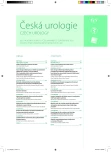Possibilities of endoscopic management of retained incrusted ureteral stents
Authors:
Petra Kočovská 1; Viktor Eret 1; Pavla Toufarová 1; Zdeněk Chudáček 2; Milan Hora 1
Authors‘ workplace:
Urologická klinika LF UK a FN, Plzeň
1; Radiodiagnostické oddělení LF UK a FN
Plzeň
2
Published in:
Ces Urol 2012; 16(2): 101-107
Category:
Original article
Overview
Aim:
On long-term kept ureteral stents are formed incrustations, which gradually become bigger and present a complicated situation even foran experienced endourologist. The aim of this article is to demonstrate our experience with endoscopic solutions of this problem.
Material and method:
Since 1/2010 to 2/2012 there have been 10 cases of incrustant stents solved with 6 patients, 4 women and 2 men, at the Department of Urology at University Hospital in Pilsen. In 4 cases the stent was inserted due to secondary megaureter, in 3 cases due to ureterolithiasis and in 3 cases due to hydronephrosis. The average time of keeping the stent was 16.7 months (between 7 and 33 months). All patients forgot about the inserted stent. For the diagnosis we used intravenous urography in two cases, computer tomography in 5 cases, plain abdominal X-ray in 1 case and ultrasonography in 2 cases.
Results:
In all 10 cases the incrustations were presenton the distal end of the stent, in 6 cases also a proximal end was incrusted and in 2 cases the whole stent, including the middle part, was incrusted. In 7 cases we used a combined endoscopic approach as a solution. All 6 patients are currently without lithiasis, two of them have permanently inserted stents due to secondary megaureters bilaterally. Analysis of the incrutstations proved that it was a mixed lithiasis. In 7 cases predominated apatite, in 3 cases struvite.
Conclusion:
Although patients sometimes forget about inserted stents, on which incrustation is formed after recommended time of keeping, it is possible to solve their problem with a quite high percentage of success.
Key words:
endoscopy, incrustation, stent.
Sources
1. Saltzman B. Ureteral stents. Indications, variations, and complications. Urol Clin North Am 1988; 15: 481–491.
2. Chew BH, Knudsen BE, Denstedt JD. Th e use of stenos in contemporary urology. Curr Opin Urol 2004; 14: 111–115.
3. Hepperlen TW, Mardis HK, Kammandel H. Th e pigtail ureteral stent in the cancer patient. J Urol 1979; 121: 17–18.
4. Hlaváčová J, Jambura J, Kouba J, Bulka J, Eret V, Hora M. Časná chirurgická léčba poranění ureterů. Čes Urol 2011; 15(3): 158–166.
5. Park DS, Park JH, Lee YT. Percutaneous nephrostomy versus indwelling ureteral stents in patients with bilateral nongenitourinary malignant extrinsic obstruction. J Endourol 2002; 16: 153–154.
6. Kuno K, Menzin A, Kauder HH, Sison C, Gal D. Prophylactic ureteral catheterization in gynecologic surgery. Urology 1998; 52: 1004–1008.
7. Damiano R, Oliva A, Esposito C, De Sio M, Autorino R, D’Armiento M. Early and late complications of double pigtail ureteral stent. Urol Int 2002; 69: 136–140.
8. Schulze KA, Wettlaufer JN, Oldani G. Encrustation and stone formation: complication of indwelling ureteral stenos. Urology 1985; 25: 616–619.
9. Monga M, Klein E, Castaneda-Zúniga WR,Th omas R. Th e forgotten indwellling ureteral stent: a urological dilemma. J Urol 1995; 153: 1817–1819.
10. Mohan-Pillai K, Keeley FX jr., Moussa SA, et al. Endourological management of severely encrusted ureteral stents. J Endourol 1999; 13: 377.
11. El-Faqih SR, Shamsuddin AB, Chakrabarti A, Atassi R, Kardar AH,Osman MK, et al. Polyurethane internal ureteral stents in treatment of stone pacients: morbidity related to indwelling times. J Urol 1991; 146: 1487–1491.
12. Borboroglu PG, Kane CJ. Current mangement of severely encrusted ureteral stents with a large associated stone burden. J Urol 2000; 164: 648–650.
13. Murthy KV, Reddy SJ, Prasad DV. Endourological management of forgotten encrusted ureteral stents. Int Braz J Urol 2010; 36: 420–429.
14. Hora M. Ureterální stenty (Ureteral stents). RVAU 1995; 17: 239–247. ISSN 1212-320X.
15. Dindo D, Demartines N, Clavien PA. Classifi cation of Surgical Complications. A New Proposal With Evaluation in a Cohort of 6336 Patients and Results of a Survey. Ann Surg 2004; 240(2): 205–213.
16. Matějková M, Všetička J. Komplikace zavedených pigtail stentů u non-compliantních pacientů ze sociálně slabé vrstvy. Urol praxi 2012; 13(2): 88–89.
Labels
Paediatric urologist Nephrology UrologyArticle was published in
Czech Urology

2012 Issue 2
Most read in this issue
- Early salvage radiotherapy following radical prostatectomy indicated in patients with rising PSA levels below the conventional threshold of biochemical recurrence 0.2 ng/ml
- Possibilities of endoscopic management of retained incrusted ureteral stents
- Intestinal metaplasia of bladder mucosa in combination with Peutz Jeghers syndrome
- Failure of local treatment of prostate cancer
